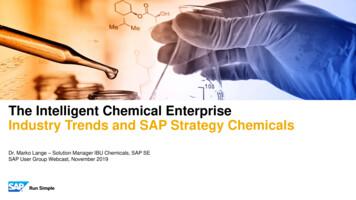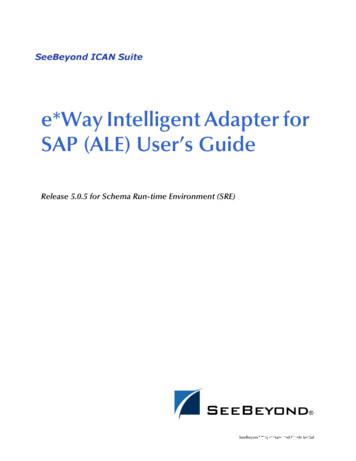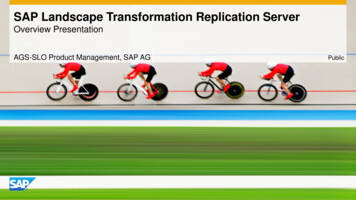Practical Guide To SAP CO-PC (Product Cost Controlling)
Practical Guideto SAP CO-PC(Product CostControlling)Tanya Duncan
TABLE OF CONTENTSTable of ContentsAcknowledgments5Preface71 Introduction to Product Costing111.1What is product costing?111.2Organizational hierarchy121.3Navigating this book151.4Tips for reading this book162 Product Cost Planning192.1Profit centers192.2Cost centers232.3Cost elements262.4Activity types302.5Statistical key figures352.6Cost center planning362.7Allocations442.8Activity rate calculation473 Material Masters513.1Fit, form, function513.2Basic data 1 view533.3MRP 1 view563.4MRP 2 view583
TABLE OF CONTENTS3.5MRP 4 view633.6Accounting 1 view653.7Accounting 2 view723.8Costing 1 view733.9Costing 2 view823.10 Material valuation configuration4 Costing Run Execution851014.1Costing related configuration1024.2Costing run processes1375 Actual Costs & Month-End Processes1755.1Cost flow through system1765.2CO integration with other modules1815.3Month-end processing1865.4Actual allocations2015.5Work in process (WIP) configuration2065.6Variances configuration2145.7Settlement configuration2166 Closing Words219A About the Author223B Index225C Disclaimer229D Credits2314
2 Product Cost PlanningThe beginning of the product cost planning cycle iscost center planning. The goal of cost center planning is to create activity rates used in product costing, as well as allow for variance analysis and under/over absorption by cost center.Before explaining details on cost center variance analysis and activity rate calculation, we will start with foundational knowledge of controlling master data. Profit centers, cost centers, cost elements, statistical key figures,and activity rates are key controlling master data required in product costing. An understanding of thesecomponents of master data is important as you buildyour understanding of product cost planning.2.1Profit centersProfit centers represent an organizational unit in theaccounting and controlling modules in SAP. They reflecta management-oriented structure of the enterprise forthe purpose of internal control. Both expense and revenue postings require a profit center in order to build aprofitability view by profit center. Profit centers are created for revenue generating areas such as product lines,divisions, regions, or functions.Profit center postings are generated in parallel to postings made in the controlling module and the results arereviewed in a separate ledger. The configuration foractivating profit center accounting can be accessedthrough transaction OKKP or through the IMG menu19
PRODUCT COST PLANNINGpath CONTROLLING GENERAL CONTROLLING ORGANIZATION MAINTAIN CONTROLLING AREA.Profit centers are assigned to balance sheet items likeassets, payables, receivables, and inventory. Profit centers are also assigned to material masters and cost centers in order to derive a profit center on each posting.Profit centers are created in transaction KE51. They arespecific to a controlling area and are extended to relevant company codes in the company code tab. You canalso assign profit centers to company codes in massusing transaction KE56 (see Figure 2.1).Figure 2.1: Display profit center20
PRODUCT COST PLANNINGA dummy profit center ‘999’ should be created in eachcompany code. The dummy profit center is used as adefault profit center when a profit center cannot be determined. The balance in this profit center should bereviewed at month-end and year-end to move any coststhat are not assigned properly. Dummy profit centers arecreated in transaction KE59 and the dummy profit centerindicator is automatically set on the indicators tab.Partner profit center is important in profit center consolidations where costs and revenues result from inter orintracompany transactions. Partner profit center is configured to show the sender and receiver relationshipbetween costs. It can be used in postings resulting fromcost allocations or purchases where costs are movedfrom one profit center to another.Partner profit centers can be derived from the supplyingobject if the sender is in the same SAP version. Derivation rules can also be configured if the supplier is not inthe same SAP version using vendor, customer, material,company, etc.Profit center analysis period tipWhen creating a profit center, ensurethat the analysis period date rangematches the date range of cost centers.If a profit center is created with a smallerdate range than that of a cost center, you will receivean error when you try to assign the profit center to acost center.21
PRODUCT COST PLANNINGThe person responsible and profit center group are required fields. You can assign profit centers to companycodes on the company code tab. The address and communication tabs are optional and provide fields for indicating contact information for a profit center owner.Activate profit center warning!After you save a newly created orchanged profit center, note that the status on the basic data tab is inactive. Youmust click the matchstick button to activate the new profit center after youmake modifications.2.1.1 Profit center hierarchyA profit center hierarchy is required for each controllingarea. Within a profit center hierarchy, you create profitcenter groups to combine like profit centers for reportingand profit center allocations (if applicable). Typically hierarchy requirements for grouping profit centers comefrom executive leadership.Profit center group exampleYou may want to group together profitcenters that are produced using a certain type of product, or multiple profitcenters that represent a division of thecompany. P&G, for example, may grouphealth products in one profit center group separatefrom home cleaning products.22
PRODUCT COST PLANNINGYou can build your hierarchy many levels deep toachieve the level of reporting desired. The profit centergroup you assign in the profit center master data is thelowest level group above the profit center. The profitcenter hierarchy can be changed or displayed in transaction KCH6N (see Figure 2.2).Figure 2.2: Display profit center hierarchy2.2Cost centersCost centers are used to manage the expenses of departments and provide decision-making data for management. This requires that all costs be assigned according to their source. While expenses may temporarilybe held on projects, internal orders, or manufacturingorders, they are eventually settled to cost centers as afinal cost object.Cost center accounting lets you analyze overhead costsaccording to where they were incurred within the organization. In addition to plan versus actual analysis, youcan also see the under/over absorption by cost center.This is an important analysis to perform when planningactivity rates for product costing. If a cost center was23
INDEXB IndexAAccount assignmentgroup 184Accounting 1 view 65Accounting 2 view 72Activity rate calculation47Activity type 30Activity type rate 47Actual costs 175Additive cost 136Alternative BOM 79Assembly scrappercentage 58Assessment 44, 202BBackflush 62Balance sheet 14Base quantity 142Base unit of measure53Bill of Material (BOM)68, 142BOM usage 79Bulk material 63Business ProcessConsolidations (BPC)186CCompany code 13Continuous production147Controlling area. 12Co-product 81Cost center 23Cost center category25Cost center group 26Cost center hierarchy26Cost center planning19Cost center splitting 48Cost componentstructure 103, 122Cost element 26Cost element group 30Costing 1 view 73Costing 2 view 82Costing lot size 82Costing sheet 125Costing type 113Costing variant 102Cross-plant materialstatus 56Current price 84225
INDEXDDiscontinuousproduction 147Discrete manufacturing144Distribution 44, 202Do Not Cost 74Dummy profit center 21FFixed price co-product81Formula 182Functional area 24Future price 82GGroup counter 79Make to orderproduction 144Make to stock 176Mark 151Master recipe 147Material group 54Material master 51Material origin 78Material type 51Mixed costing 133Moving average price68MRP 56MRP 1 view 56MRP 2 view 58MRP 4 view 63OIncome statement 14Old material number 55Operating concern 13Origin group 74, 120Overhead group 75JPJoint production 81Partner profit center 21,186Planned order 145Planned price 1, 2, 384Plant 13Plant-specific materialstatus 57Previous price 84Price control 68ILLIFO pool 73LIFO relevancy 73MMake to order 179226
INDEXPrice unit 70, 73Pricing condition 185Primary cost element27Process manufacturing147Process order 147Process-oriented filling147Procurement type 59Product cost collector(PCC) 170Product cost estimate101Product hierarchy 55Production order 144Production version 64Profit and lossstatement 14Profit center 19Profit center hierarchy22Purchase informationrecord 185Purchase informationrecord (PIR) 110QQuantity structure 79,116RRegulated production147Release 154Reorganization 167Repetitivemanufacturing 145Routing 68, 144SSales condition 184Secondary cost element28Selection method 64Settlement 199Settlement profile 199Settlement rule 199Special procurementkey 61Special procurementkey for costing 80Split valuation 70Standard cost 68Standard value key 182Statistical key figure 35Storage location 14TTask list group 79Task list type 79Tax and commercialprice fields 72Transfer control 117Rate routing 145227
INDEXUUnit cost estimate 136VValuated sales orderstock 179Valuation category 70Valuation class 66Valuation variant 103228Variance calculation195Variance key 78WWith Quantity Structure77Work in processcalculation 189
3.8 Costing 1 view 73 3.9 Costing 2 view 82 3.10 Material valuation configuration 85 4 Costing Run Execution 101 4.1 Costing related configuration 102 4.2 Costing run processes 137 5 Actual Costs & Month-End Processes 175 5.1 Cost flow through system 176 5.2 CO integration with other modules 181 5.3 Month-end processing 186File Size: 442KB
SAP ERP SAP HANA SAP CRM SAP HANA SAP BW SAP HANA SAP Runs SAP Internal HANA adoption roadmap SAP HANA as side-by-side scenario SAP BW powered by SAP HANA SAP Business Suite powered by SAP HANA Simple Finance 1.0 2011 2013 2014 2015 Simple Finance 2.0 S/4 HANA SAP ERP sFin Add-On 2.0
SAP Certification Material www.SAPmaterials4u.com SAP Certification Material for SAP Aspirants at Low cost Home Home SAP Business Objects SAP BPC CPM SAP BPC 7.0 SAP EWM SAP GTS SAP Public Sector SAP Real Estate SAP FSCM SAP FI/CO SAP AC - FI/CO SAP BI 7.0 SAP CRM 5.0
SAP Master Data Governance SAP Information Steward SAP HANA smart data integration SAP Data Hub SAP Cloud Platform Big Data Services SAP HANA, platform edition SAP Vora Customer Experience IoT Workforce Engagement SAP Cloud for Customer SAP Commerce SAP Marketing SAP Asset Intelligence Network SAP Predictive Maintenance and Service SAP .
ALE/RFC Setup 88 SAP System Type 88 SAP IDoc Version 88 Program ID (SAP to e*Gate) 88 SAP Load Balancing Usage (e*Gate to SAP) 89 SAP Application Server (e*Gate to SAP) 89 SAP Router String (e*Gate to SAP) 90 SAP System Number (e*Gate to SAP) 90 SAP Gateway Ho
SAP HANA Appliance SAP HANA DB In-Memory A io BI Client non-ABAP (SAP supported DBs) SAP Business Suite SAP Business Suite SAP Business Suite SAP Business Suite SAP Business Suite SAP Business Suite SAP Business Warehouse SAP HANA DB r In-Memory Source Systems SAP LT Replication Ser
Customer Roadmap to SAP Simple Finance - Example " Adopting SAP Simple Finance is a journey - start early" Side-by-side SAP HANA Acceleration SAP HANA accelerators, BW, BPC, GRC SAP Business Suite on SAP HANA SAP ERP on SAP HANA SAP ERP in SAP HANA Enterprise Cloud SAP Accounting Powered By SAP HANA Simple Finance add-on/
SAP Business Suite SAP BW SAP Apps Partner Apps SAP HANA PLATFORM Planning and Calculation Engine Real-Time Replication Services Information Composer & Modeling Studio SAP UI HTML5 Mobile SAP BI 4 SAP ERP SAP CRM SAP SCM SAP PLM SAP SRM SAP Netweaver Predictive Analytics & Business Function Libraries In-Memory
Sep 28, 2021 · SAP LLC “SAP Labs“ MEE Russian Federation SAP SAP CIS, LLC MEE Serbia SAP SAP West Balkans d.o.o. MEE Slovakia SAP SAP Slovensko s.r.o. MEE Slovakia SAP Ariba Ariba Slovak Republic, s.r.o. MEE Slovenia SAP SAP sistemi, aplikacije in produkti za obdelavo podatkov d.o.o. MEE Switzerland Emarsys Emarsys Schweiz GmbHFile Size: 598KB























